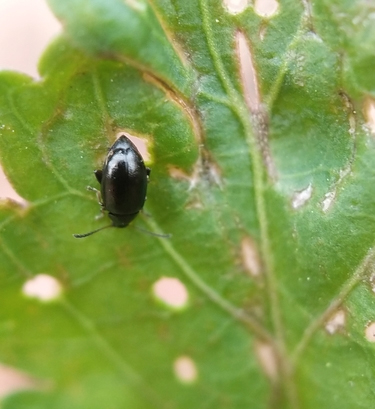MORE INFORMATION:
North Dakota State University - Extension
PNW Pest Management Handbook
Crucifer flea beetle (Phyllotreta cruciferae)
Biology and life history: The crucifer flea beetle and striped flea beetle (P. striolata) are the most serious pests of cruciferous crops, with the former being more abundant than the later in most of North America. The adult is small (0.1 inch) and oval-shaped with shiny metallic blue-black elytra (wing covers), while the striped flea beetle is black with two wavy yellow stripes (hence the name) on their elytra. Both species are good fliers. Using their enlarged hind legs, they can also jump (like fleas) great distances. It has a single generation a year and overwinters as an adult under leaf litter, mulches, or stubble. The adult emerges when temperatures warm up in spring and start feeding on newly emerged canola, weeds, or other available cruciferous crops. During summer, the adult deposits eggs in the soil. Larvae feeds on roots of host plants and pupate. Adults emerge late summer, feeding on foliage in late summer and fall before overwintering.
Host plants and crop damage: Unlike other flea beetles, crucifer flea beetles and striped flea beetles attack predominantly cruciferous plants such as canola, mustard, cabbage, turnip, radish, broccoli, kale, cabbage, collards, and weeds such as wild mustard and field pennycress. Larvae feed belowground plant parts while adults feed the aboveground foliage. Adult feeding produces pits or small holes that can cover extensive portions of the leaf with heavy infestations. Heavy infestations can kill seedlings, significantly reduce the marketability of crops, or even cause total crop loss.
Management: Crucifer flea beetles overwinter as adults and emerge in spring, when they can cause significant damage to young seedlings. Therefore, monitoring for flea beetles should begin in spring or within a few days of crop emergence during sunny and warm days. Cultural control such as adjusting planting dates, trap cropping, rotating crops, managing field edges, and planting companion plants are effective ways to manage this pest. Mechanical and physical control such as floating row covers, and sticky traps help exclude or remove the flea beetles from crop. Natural enemies such as parasitoid wasps, lacewing larvae, big-eyed bugs, spiders, and damsel bugs kill flea beetles. Habitat management including enhancing floral resources can support these beneficial insects. Entomopathogenic nematodes and fungal pathogens also kill flea beetles. Safer foliar treatments may be necessary in areas with high beetle pressure with feeding damage exceeding 25% on cotyledons and first true leaves.

